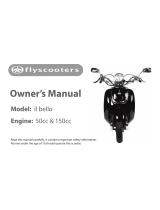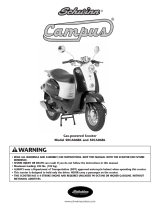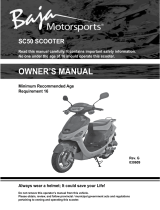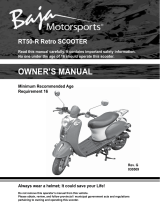Page is loading ...

OWNER’S MANUAL
2B6-F8199-E0
CW50 / CW50L / CW50N


INTRODUCTION
EAU10110
Welcome to the Yamaha world of motorcycling!
As the owner of the CW50/CW50L/CW50N, you are benefiting from Yamaha’s vast experience and newest technology re-
garding the design and manufacture of high-quality products, which have earned Yamaha a reputation for dependability.
Please take the time to read this manual thoroughly, so as to enjoy all advantages of your CW50/CW50L/CW50N. The own-
er’s manual does not only instruct you in how to operate, inspect and maintain your scooter, but also in how to safeguard
yourself and others from trouble and injury.
In addition, the many tips given in this manual will help keep your scooter in the best possible condition. If you have any fur-
ther questions, do not hesitate to contact your Yamaha dealer.
The Yamaha team wishes you many safe and pleasant rides. So, remember to put safety first!

IMPORTANT MANUAL INFORMATION
EAU10150
Particularly important information is distinguished in this manual by the following notations:
N
O
TE:
● This manual should be considered a permanent part of this scooter and should remain with it even if the scooter is sub-
sequently sold.
● Yamaha continually seeks advancements in product design and quality. Therefore, while this manual contains the most
current product information available at the time of printing, there may be minor discrepancies between your scooter and
this manual. If you have any questions concerning this manual, please consult your Yamaha dealer.
WARNING
EWA10030
PLEASE READ THIS MANUAL CAREFULLY AND COMPLETELY BEFORE OPERATING THIS SCOOTER.
The Safety Alert Symbol means ATTENTION! BECOME ALERT! YOUR SAFETY IS
INVOLVED!
Failure to follow WARNING instructions could result in severe injury or death
to the
scooter operator, a bystander, or a person inspecting or repairing the scooter.
A CAUTION indicates special precautions that must be taken to avoid damage to
the scooter.
A NOTE provides key information to make procedures easier or clearer.
WARNING
CAUTION:
NOTE:

IMPORTANT MANUAL INFORMATION
EAUM1010
CW50/CW50L/CW50N
OWNER’S MANUAL
©2004 by MBK INDUSTRIE
1st edition, February 2004
All rights reserved
Any reprinting or unauthorized use
without the written permission of
MBK INDUSTRIE
is expressly prohibited.
Printed in France.

TABLE OF CONTENTS
SAFETY INFORMATION ..................1-1
Further safe-riding points ................1-4
DESCRIPTION ..................................2-1
Left view ..........................................2-1
Right view........................................2-2
INSTRUMENT AND CONTROL
FUNCTIONS .......................................3-1
Main switch/steering lock ................3-1
Indicator and warning lights ............3-2
Speedometer unit
(CW50/CW50L)............................3-3
Speedometer unit (CW50N) ............3-4
Fuel gauge (CW50/CW50L) ............3-4
Handlebar switches ........................3-5
Front brake lever ............................3-5
Rear brake lever .............................3-6
Fuel and 2-stroke engine oil
tank caps .....................................3-6
Fuel .................................................3-7
Catalytic converter ..........................3-7
2-stroke engine oil ..........................3-8
Kickstarter .......................................3-8
Securing bracket .............................3-8
Seat ................................................3-9
Anti-theft device housing ................3-9
Luggage hook ...............................3-10
Adjusting the shock
absorber assembly
(CW50L model only) ..................3-10
PRE-OPERATION CHECKS ............. 4-1
Pre-operation check list .................. 4-2
OPERATION AND IMPORTANT
RIDING POINTS................................. 5-1
Starting a cold engine .................... 5-1
Starting off ...................................... 5-2
Acceleration and deceleration ........ 5-2
Braking ........................................... 5-3
Tips for reducing fuel
consumption ...............................5-3
Engine break-in ..............................5-4
Parking ........................................... 5-4
PERIODIC MAINTENANCE AND
MINOR REPAIR ................................. 6-1
Periodic maintenance and
lubrication chart .......................... 6-2
Removing and installing the
cowling and panels ..................... 6-5
Checking the spark plug ................. 6-6
Final transmission oil ...................... 6-7
Cleaning the air filter element ........6-8
Adjusting the carburetor ................. 6-9
Adjusting the throttle cable
free play ...................................... 6-9
Tires ............................................. 6-10
Cast wheels .................................. 6-12
Adjusting the front brake lever
free play .................................... 6-12
Adjusting the rear brake lever
free play .................................... 6-12
Checking the front brake pads
and rear brake shoes ............... 6-13
Checking the brake fluid level ...... 6-14
Changing the brake fluid .............. 6-15
Checking and lubricating the
cables ....................................... 6-15
Checking and lubricating the
throttle grip and cable ............... 6-15
Lubricating the front and rear
brake levers .............................. 6-16
Checking and lubricating the
centerstand............................... 6-16
Checking the front fork ................. 6-16
Checking the steering .................. 6-17
Checking the wheel bearings ....... 6-18
Battery ......................................... 6-18
Replacing the fuse ....................... 6-20
Replacing a headlight bulb .......... 6-20
Replacing the tail/brake light
bulb ........................................... 6-21
Replacing a turn signal light
bulb ........................................... 6-22
Troubleshooting ........................... 6-22
Troubleshooting chart .................. 6-23
SCOOTER CARE AND STORAGE... 7-1
Care ............................................... 7-1
Storage .......................................... 7-3

1-1
1
SAFETY INFORMATION
EAU10260
SCOOTERS ARE SINGLE TRACK
VEHICLES. THEIR SAFE USE AND
OPERATION ARE DEPENDENT
UPON THE USE OF PROPER RIDING
TECHNIQUES AS WELL AS THE EX-
PERTISE OF THE OPERATOR. EV-
ERY OPERATOR SHOULD KNOW
THE FOLLOWING REQUIREMENTS
BEFORE RIDING THIS SCOOTER.
HE OR SHE SHOULD:
● OBTAIN THOROUGH INSTRUC-
TIONS FROM A COMPETENT
SOURCE ON ALL ASPECTS OF
SCOOTER OPERATION.
● OBSERVE THE WARNINGS AND
MAINTENANCE REQUIRE-
MENTS IN THE OWNER’S MAN-
UAL.
● OBTAIN QUALIFIED TRAINING
IN SAFE AND PROPER RIDING
TECHNIQUES.
● OBTAIN PROFESSIONAL TECH-
NICAL SERVICE AS INDICATED
BY THE OWNER’S MANUAL
AND/OR WHEN MADE NECES-
SARY BY MECHANICAL CONDI-
TIONS.
Safe riding
● Always make pre-operation
checks. Careful checks may help
prevent an accident.
● This scooter is designed to carry
the operator and passenger.
● The failure of motorists to detect
and recognize scooters in traffic is
the predominating cause of auto-
mobile/scooter accidents. Many
accidents have been caused by an
automobile driver who did not see
the scooter. Making yourself con-
spicuous appears to be very effec-
tive in reducing the chance of this
type of accident.
Therefore:
• Wear a brightly colored jacket.
• Use extra caution when ap-
proaching and passing through
intersections, since intersec-
tions are the most likely places
for scooter accidents to occur.
• Ride where other motorists can
see you. Avoid riding in another
motorist’s blind spot.
● Many accidents involve inexperi-
enced operators. In fact, many op-
erators who have been involved in
accidents do not even have a cur-
rent driver’s license.
• Make sure that you are qualified
and that you only lend your
scooter to other qualified opera-
tors.
• Know your skills and limits.
Staying within your limits may
help you to avoid an accident.
• We recommend that you prac-
tice riding your scooter where
there is no traffic until you have
become thoroughly familiar with
the scooter and all of its con-
trols.
● Many accidents have been caused
by error of the scooter operator. A
typical error made by the operator
is veering wide on a turn due to
EXCESSIVE SPEED or undercor-
nering (insufficient lean angle for
the speed).
• Always obey the speed limit and
never travel faster than warrant-
ed by road and traffic conditions.

SAFETY INFORMATION
1-2
1
• Always signal before turning or
changing lanes. Make sure that
other motorists can see you.
● The posture of the operator and
passenger is important for proper
control.
• The operator should keep both
hands on the handlebar and
both feet on the footboard during
operation to maintain control of
the scooter.
• The passenger should always
hold onto the operator, the seat
strap or grab bar, if equipped,
with both hands and keep both
feet on the passenger footrests.
• Never carry a passenger unless
he or she can firmly place both
feet on the passenger footrests.
● Never ride under the influence of
alcohol or other drugs.
● This scooter is designed for on-
road use only. It is not suitable for
off-road use.
Protective apparel
The majority of fatalities from scooter
accidents are the result of head inju-
ries. The use of a safety helmet is the
single most critical factor in the preven-
tion or reduction of head injuries.
● Always wear an approved helmet.
● Wear a face shield or goggles.
Wind in your unprotected eyes
could contribute to an impairment
of vision which could delay seeing
a hazard.
● The use of a jacket, substantial
shoes, trousers, gloves, etc., is ef-
fective in preventing or reducing
abrasions or lacerations.
● Never wear loose-fitting clothes,
otherwise they could catch on the
control levers or wheels and cause
injury or an accident.
● Never touch the engine or exhaust
system during or after operation.
They become very hot and can
cause burns. Always wear protec-
tive clothing that covers your legs,
ankles, and feet.
● Passengers should also observe
the above precautions.
Modifications
Modifications made to this scooter not
approved by Yamaha, or the removal of
original equipment, may render the
scooter unsafe for use and may cause
severe personal injury. Modifications
may also make your scooter illegal to
use.
Loading and accessories
Adding accessories or cargo to your
scooter can adversely affect stability
and handling if the weight distribution of
the scooter is changed. To avoid the
possibility of an accident, use extreme
caution when adding cargo or accesso-
ries to your scooter. Use extra care
when riding a scooter that has added
cargo or accessories. Here are some
general guidelines to follow if loading
cargo or adding accessories to your
scooter:
Loading
The total weight of the operator, pas-
senger, accessories and cargo must
not exceed the maximum load limit of
185 kg (408 lb). When loading within
this weight limit, keep the following in
mind:

SAFETY INFORMATION
1-3
1
● Cargo and accessory weight
should be kept as low and close to
the scooter as possible. Make sure
to distribute the weight as evenly
as possible on both sides of the
scooter to minimize imbalance or
instability.
● Shifting weights can create a sud-
den imbalance. Make sure that ac-
cessories and cargo are securely
attached to the scooter before
riding. Check accessory mounts
and cargo restraints frequently.
● Never attach any large or heavy
items to the handlebar, front fork,
or front fender. Such items can
create unstable handling or a slow
steering response.
Accessories
Genuine Yamaha accessories have
been specifically designed for use on
this scooter. Since Yamaha cannot test
all other accessories that may be avail-
able, you must personally be responsi-
ble for the proper selection, installation
and use of non-Yamaha accessories.
Use extreme caution when selecting
and installing any accessories.
Keep the following guidelines in mind,
as well as those provided under “Load-
ing” when mounting accessories.
● Never install accessories or carry
cargo that would impair the perfor-
mance of your scooter. Carefully
inspect the accessory before using
it to make sure that it does not in
any way reduce ground clearance
or cornering clearance, limit sus-
pension travel, steering travel or
control operation, or obscure lights
or reflectors.
• Accessories fitted to the handle-
bar or the front fork area can
create instability due to improper
weight distribution or aerody-
namic changes. If accessories
are added to the handlebar or
front fork area, they must be as
lightweight as possible and
should be kept to a minimum.
• Bulky or large accessories may
seriously affect the stability of
the scooter due to aerodynamic
effects. Wind may attempt to lift
the scooter, or the scooter may
become unstable in cross
winds. These accessories may
also cause instability when
passing or being passed by
large vehicles.
• Certain accessories can dis-
place the operator from his or
her normal riding position. This
improper position limits the free-
dom of movement of the opera-
tor and may limit control ability,
therefore, such accessories are
not recommended.
● Use caution when adding electri-
cal accessories. If electrical acces-
sories exceed the capacity of the
scooter’s electrical system an
electric failure could result, which
could cause a dangerous loss of
lights or engine power.
Gasoline and exhaust gas
● GASOLINE IS HIGHLY FLAMMA-
BLE:
• Always turn the engine off when
refueling.
• Take care not to spill any gaso-
line on the engine or exhaust
system when refueling.
• Never refuel while smoking or in
the vicinity of an open flame.

SAFETY INFORMATION
1-4
1
● Never start the engine or let it run
for any length of time in a closed
area. The exhaust fumes are poi-
sonous and may cause loss of
consciousness and death within a
short time. Always operate your
scooter in an area that has ade-
quate ventilation.
● Always turn the engine off before
leaving the scooter unattended
and remove the key from the main
switch. When parking the scooter,
note the following:
• The engine and exhaust system
may be hot, therefore, park the
scooter in a place where pedes-
trians or children are not likely to
touch these hot areas.
• Do not park the scooter on a
slope or soft ground, otherwise it
may fall over.
• Do not park the scooter near a
flammable source (e.g., a kero-
sene heater, or near an open
flame), otherwise it could catch
fire.
● If you should swallow any gaso-
line, inhale a lot of gasoline vapor,
or allow gasoline to get into your
eyes, see your doctor immediately.
If any gasoline spills on your skin
or clothing, immediately wash the
affected area with soap and water
and change your clothes.
EAU10370
Further safe-riding points
● Be sure to signal clearly when
making turns.
● Braking can be extremely difficult
on a wet road. Avoid hard braking,
because the scooter could slide.
Apply the brakes slowly when
stopping on a wet surface.
● Slow down as you approach a cor-
ner or turn. Once you have com-
pleted a turn, accelerate slowly.
● Be careful when passing parked
cars. A driver might not see you
and open a door in your path.
● Railroad crossings, streetcar rails,
iron plates on road construction
sites, and manhole covers be-
come extremely slippery when
wet. Slow down and cross them
with caution. Keep the scooter up-
right, otherwise it could slide out
from under you.
● The brake pads could get wet
when you wash the scooter. After
washing the scooter, check the
brakes before riding.

SAFETY INFORMATION
1-5
1
● Always wear a helmet, gloves,
trousers (tapered around the cuff
and ankle so they do not flap), and
a bright colored jacket.
● Do not carry too much luggage on
the scooter. An overloaded scoot-
er is unstable.

DESCRIPTION
2-1
2
EAU10410
Left view
1 23
45 6
789
10
CW50N
CW50L
1 23
1. Rear brake lever (page 3-6)
2. Speedometer unit (page 3-3)
3. Left handlebar switches (page 3-5)
4. Kickstarter (page 3-8)
5. Air filter element (page 6-8)
6. Final transmission oil filler cap (page 6-7)
7. Final transmission oil drain bolt (page 6-7)
8. Centerstand (page 6-16)
9. Battery/Fuse (page 6-18/6-20)
10.Shock absorber assembly spring preload adjusting ring (CW50L
model only) (page 3-10)

DESCRIPTION
2-2
2
EAU10420
Right view
2
87
3 4 5 61
9
4 56
CW50N
1. Grab bar (page 5-2)
2. Oil tank cap (page 3-6)
3. Fuel tank cap (page 3-6)
4. Throttle grip (page 6-9)
5. Right handlebar switch (page 3-5)
6. Front brake lever (page 3-5)
7. Luggage hook (page 3-10)
8. Anti-theft device housing (page 3-9)
9. Securing bracket (page 3-8)

INSTRUMENT AND CONTROL FUNCTIONS
3-1
3
EAU10460
Main switch/steering lock
The main switch/steering lock controls
the ignition and lighting systems, and is
used to lock the steering. The various
positions are described below.
EAU10640
ON “”
All electrical circuits are supplied with
power, and the engine can be started.
The key cannot be removed.
NOTE:
The headlight, meter lighting and tail-
light come on automatically when the
engine is started.
EAU10660
OFF “”
All electrical systems are off. The key
can be removed.
EAU10670
CHECK “”
The 2-stroke engine oil level warning
light should come on. (See page 3-2.)
EAU10680
LOCK “”
The steering is locked, and all electrical
systems are off. The key can be re-
moved.
To lock the steering
1. Turn the handlebars all the way to
the left.
2. Push the key in from the “” posi-
tion, and then turn it to “” while
still pushing it.
3. Remove the key.
To unlock the steering
Push the key in, and then turn it to “”
while still pushing it.
WARNING
EWA10060
Never turn the key to “” or “”
while the vehicle is moving, other-
wise the electrical systems will be
switched off, which may result in
loss of control or an accident. Make
sure that the vehicle is stopped be-
fore turning the key to “” or “”.
PUSH
OPEN
ZAUM0253

INSTRUMENT AND CONTROL FUNCTIONS
3-2
3
EAU11001
Indicator and warning lights
CW50/CW50L
CW50N
EAU11030
Turn signal indicator lights “” and
“” (CW50/CW50L)
The corresponding indicator light flash-
es when the turn signal switch is
pushed to the left or right.
EAU11020
Turn signal indicator light “”
(CW50N)
This indicator light flashes when the
turn signal switch is pushed to the left or
right.
EAU11080
High beam indicator light “”
This indicator light comes on when the
high beam of the headlight is switched
on.
EAU11180
Oil level warning light “”
This warning light comes on when the
key is in the “” position or when the oil
level in the 2-stroke engine oil tank is
low during operation. If the warning
light comes on during operation, stop
immediately and fill the oil tank with Ya-
malube 2 or equivalent 2-stroke engine
oil of either JASO grade “FC” or ISO
grades “EG-C” or “EG-D”. The warning
light should go off after the 2-stroke en-
gine oil tank has been refilled.
NOTE:
If the warning light does not come on
when the key is in the “” position or
does not go off after the 2-stroke en-
gine oil tank has been refilled, have a
Yamaha dealer check the electrical cir-
cuit.
1. Left turn signal indicator light “”
2. Right turn signal indicator light “”
3. High beam indicator light “”
4. Oil level warning light “”
12
34
ZAUM0554
1. Fuel level warning light “”
2. High beam indicator light “”
3. Oil level warning light “”
4. Turn signal indicator light “”
12 34
ZAUM0522

INSTRUMENT AND CONTROL FUNCTIONS
3-3
3
CAUTION:
ECA10010
Do not operate the vehicle until you
know that the engine oil level is suf-
ficient.
EAUM1570
Fuel level warning light “”
(CW50N)
This warning light comes on and the
last two segments of the fuel meter will
start to flash when the fuel level drops
below approximately 0.6 L (0.17 US
gal) (0.14 Imp.gal). When this occurs,
refuel as soon as possible.
NOTE:
● Do not allow the fuel tank to empty
itself completely.
● The electrical circuit of the warning
light can be checked as follows.
Turn the key to “”. If the warning light
does not come on, have a Yamaha
dealer check the electrical circuit.
EAU11620
Speedometer unit
(CW50/CW50L)
UK only
ZAUM0524
1. Speedometer
2. Odometer
1. Speedometer
2. Odometer
12
ZAUM0555
12
ZAUM0590

INSTRUMENT AND CONTROL FUNCTIONS
3-4
3
The speedometer unit is equipped with
a speedometer and an odometer. The
speedometer shows riding speed. The
odometer shows the total distance trav-
eled.
EAUM1590
Speedometer unit (CW50N)
The speedometer unit is equipped with
a speedometer, an odometer and a fuel
meter. The speedometer shows riding
speed. The odometer shows the total
distance traveled. The fuel meter indi-
cates the amount of fuel in the fuel tank.
(see page 3-2 for an explanation of the
fuel level warning light.)
EAU12110
Fuel gauge (CW50/CW50L)
The fuel gauge indicates the amount of
fuel in the fuel tank. The needle moves
towards “E” (Empty) as the fuel level
decreases. When the needle reaches
“E”, approximately 1.2 L (0.32 US gal)
(0.26 Imp.gal) of fuel remain in the fuel
tank. If this occurs, refuel as soon as
possible.
NOTE:
Do not allow the fuel tank to empty itself
completely.
1. Speedometer
2. Odometer
3. Fuel meter
12 3
ZAUM0523
1. Fuel gauge
1
ZAUM0556

INSTRUMENT AND CONTROL FUNCTIONS
3-5
3
EAU12342
Handlebar switches
Left
Right
EAU12400
Dimmer switch “ / ”
Set this switch to “” for the high
beam and to “” for the low beam.
EAU12460
Turn signal switch “ / ”
To signal a right-hand turn, push this
switch to “”. To signal a left-hand
turn, push this switch to “”. When re-
leased, the switch returns to the center
position. To cancel the turn signal
lights, push the switch in after it has re-
turned to the center position.
EAU12500
Horn switch “”
Press this switch to sound the horn.
EAUM1130
Start switch “”
Push this switch while applying the
front or rear brake to crank the engine
with the starter.
CAUTION:
ECA10050
See page 5-1 for starting instruc-
tions prior to starting the engine.
EAU12900
Front brake lever
The front brake lever is located on the
right handlebar grip. To apply the front
brake, pull this lever toward the handle-
bar grip.
1. Horn switch “”
2. Turn signal switch “ / ”
3. Dimmer switch “ / ”
1. Start switch “”
1
2
3
ZAUM0557
1
ZAUM0473
1. Front brake lever
1
ZAUM0084

INSTRUMENT AND CONTROL FUNCTIONS
3-6
3
EAU12950
Rear brake lever
The rear brake lever is located on the
left handlebar grip. To apply the rear
brake, pull this lever toward the handle-
bar grip.
EAU13200
Fuel and 2-stroke engine oil
tank caps
The fuel tank cap and the 2-stroke en-
gine oil tank cap are located under the
seat. (See page 3-9.)
Fuel tank cap
To remove the fuel tank cap, turn it
counterclockwise, and then pull it off.
To install the fuel tank cap, turn it clock-
wise.
2-stroke engine oil tank cap
To remove the 2-stroke engine oil tank
cap, pull it off.
To install the 2-stroke engine oil tank
cap, push it into the oil tank opening.
WARNING
EWA10140
Make sure that the fuel and 2-stroke
engine oil tank caps are properly in-
stalled before riding the scooter.
1. Rear brake lever
1
ZAUM0085
1. Fuel tank cap
2. Oil tank cap
12
ZAUM0560
/






